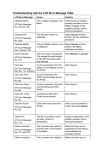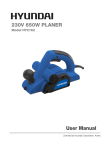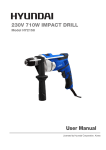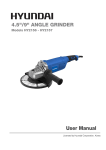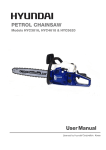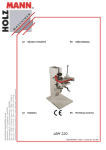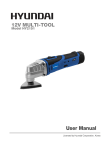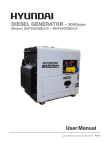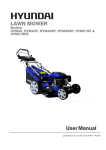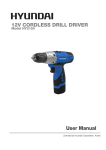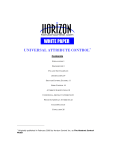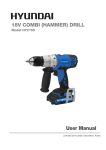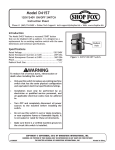Download 230V 1600 Watt Circular Saw
Transcript
230V 1600 Watt Circular Saw USER MANUAL Model shown HY2163 BEFORE USE YOU MUST READ THIS MANUAL COMPLETELY – RETAIN FOR FUTURE USE Licensed by Hyundai Corporation, Korea CONTENTS Section Description 1. OWNER’S MANUAL & SAFETY INSTRUCTIONS Page No/No’s 3 2. GENERAL SAFETY 3–5 3. SPECIFIC SAFETY INSTRUCTIONS 5–6 4. QUICK REFERENCE GUIDE and USE 5. OPERATION, CONTROLS & INSTRUCTIONS 7 7–9 6. GENERAL MAINTENANCE 10 7. SYMBOLS 10 8. ENVIRONMENTAL 10 – 11 9. GENPOWER CONTACT DETAILS 11 10. DECLARATIONS OF CONFORMITY 11 Page 2 1. OWNER’S MANUAL & SAFETY INSTRUCTIONS 1.1. How to read the manual. 1.1.1. Keep this manual for the safety warnings and precautions, assembly, operation, inspection, maintenance and cleaning procedures. 1.1.2. Write the product’s serial number in the back of the manual near the assembly diagram (or month and year of purchase if product has no number). 1.1.3. Keep this manual and the receipt in a safe and dry place for future reference. 1.1.4. The term “power tool” in the warnings refers to your mains operated (corded) power tool or battery-operated (cordless) power tool. 1.1.5. This circular saw are intended to be used for sawing wood, wood-like materials, plaster and cement-bonded fibre materials, and plastics. 2. GENERAL SAFETY Non-observance will result in the risk of serious injury or death to oneself or others. Non- observance will result in the risk of injury to oneself or others. Indicates a hazard which, if not avoided, might result in minor or moderate injury. NOTE or IMPORTANT These give details or further information on what has already been said, and aim to prevent damage to the machine or cause other damage. Read Manual DO NOT let comfort or familiarity with product (gained from repeated use) replace strict adherence to safety rules for the subject product. MISUSE or failure to follow the safety rules stated in this instruction manual may cause serious personal injury. 2.1. Work Area Safety 2.1.1. Keep work area clean and well lit. Cluttered or dark areas invite accidents. 2.1.2. Do not operate power tools in explosive atmospheres, such as in the presence of flammable liquids, gases or dust. Power tools create sparks which may ignite the dust or fumes. 2.1.3. Keep children and bystanders away while operating a power tool. Distractions can cause you to lose control. 2.2. Electrical Safety. 2.2.1. Power tool plugs must match the outlet. Never modify the plug in any way. Do not use any adapter plugs with earthed (grounded) power tools. Unmodified plugs and matching outlets will reduce risk of electric shock. 2.2.2. Avoid body contact with earthed or grounded surfaces, such as pipes, radiators, ranges and refrigerators. There is an increased risk of electric shock if your body is earthed or grounded. Page 3 2.2.3. Do not expose power tools to rain or wet conditions. Water entering a power tool will increase the risk of electric shock. 2.2.4. Do not abuse the cord. Never use the cord for carrying, pulling or unplugging the power tool. Keep cord away from heat, oil, sharp edges and moving parts. Damaged or entangled cords increase the risk of electric shock. 2.2.5. When operating a power tool outdoors, use an extension cord suitable for outdoor use. 2.2.6. Use of a cord suitable for outdoor use reduces the risk of electric shock. 2.2.7. If operating a power tool in a damp location is unavoidable, use a residual current device (RCD) protected supply. Use of an RCD reduces the risk of electric shock. 2.3. Personal Safety. 2.3.1. Stay alert, watch what you are doing and use common sense when operating a power tool. Do not use a power tool while you are tired or under the influence of drugs, alcohol or medication. A moment of inattention while operating power tools may result in serious personal injury. 2.3.2. Use personal protective equipment. Always wear eye protection. Protective equipment such as dust mask, non-skid safety shoes, hard hat, or hearing protection used for appropriate conditions will reduce personal injuries. 2.3.3. Prevent unintentional starting. Ensure the switch is in the off-position before connecting to power source and/or battery pack, picking up or carrying the tool. Carrying power tools with your finger on the switch or energizing power tools that have the switch on invites accidents. 2.3.4. Remove any adjusting key or wrench before turning the power tool on. A wrench or a key left attached to a rotating part of the power tool may result in personal injury. 2.3.5. Do not overreach. Keep proper footing and balance at all times. This enables better control of the power tool in unexpected situations. 2.3.6. Dress properly. Do not wear loose clothing or jewellery. Keep your hair, clothing and gloves away from moving parts. Loose clothes, jewellery or long hair can be caught in moving parts. 2.3.7. If devices are provided for the connection of dust extraction and collection facilities, ensure these are connected and properly used. Use of dust collection can reduce dust-related hazards. 2.4. Power Tool Use and Care. 2.4.1. Do not force the power tool. Use the correct power tool for your application. The correct power tool will do the job better and safer at the rate for which it was designed. 2.4.2. Do not use the power tool if the switch does not turn it on and off. Any power tool that cannot be controlled with the switch is dangerous and must be repaired. 2.4.3. Disconnect the plug from the power source and/or the battery pack from the power tool before making any adjustments, changing accessories, or storing power tools. Such preventive safety measures reduce the risk of starting the power tool accidentally. 2.4.4. Store idle power tools out of the reach of children and do not allow persons unfamiliar with the power tool or these instructions to operate the power tool. Power tools are dangerous in the hands of untrained users. 2.4.5. Maintain power tools. Check for misalignment or binding of moving parts, breakage of parts and any other condition that may affect the power tool’s operation. If damaged, have the power tool repaired before use. Many accidents are caused by poorly maintained power tools. 2.4.6. Keep cutting tools sharp and clean. Properly maintained cutting tools with sharp cutting edges are less likely to bind and are easier to control. Page 4 2.4.7. Use the power tool, accessories and tool bits etc. in accordance with these instructions, taking into account the working conditions and the work to be performed. 2.4.8. Use of the power tool for operations different from those intended could result in a hazardous situation. 2.5. Service. 2.5.1. Have your power tool serviced by a qualified repair person using only identical replacement parts. This will ensure that the safety of the power tool is maintained. 3. SPECIFIC SAFETY INSTRUCTIONS Read the laser safety information carefully and follow all safety precautions. Not following safety precautions could result in hazardous radiation exposure to your eyes. Use of controls or adjustments or performance of procedures other than those specified herein may result in hazardous radiation exposure. The laser should never be tilted or turned over while the laser indicator is lit. The laser energy is not dangerous to exposed skin. However, if viewed directly or form a reflection of a specular (mirror-like) surface, the emitted light from those sources may be harmful to the human eye. 3.1. Laser. 3.1.1. Do not stare into beam during operation. 3.1.2. Do not project the laser beam directly into the eyes of others. Serious eye injury could result. 3.1.3. Do not place the laser in a position, which may cause anyone to stare into the laser beam intentionally or unintentionally. 3.1.4. Do not use optical tools to view the laser beam. 3.1.5. Do not operate the laser around children or allow children to operate the laser. 3.1.6. Turn the laser off when it is not in use. 3.1.7. If laser device not were used for longer time, you shall remove the batteries; 3.1.8. Do not attempt to repairs the laser device by yourself 3.1.9. Do not attempt to change any parts of the laser device by yourself except batteries 3.1.10. Any repairs must only be carried out by the laser manufacture or authorized service agent. 3.2. Keep hands away from cutting area and the blade. Keep your second hand on motor hosing. 3.3. Do not reach underneath the work piece. 3.4. Adjust the cutting depth to the thickness of the work piece. 3.5. Never hold piece being cut in your hands or across your leg. Secure the work piece to a stable platform. 3.6. Hold power tool by insulated gripping surface when performing an operation where the cutting tool may contact hidden wiring or its own cord. 3.7. When ripping always use a rip fence or straight edge guide. 3.8. Always use blades with correct arbor hole for the too. 3.9. Never use damaged or incorrect blade washers or bolt. Page 5 3.10. Causes and operator prevention of kickback: 3.11. Kickback is the result of saw miscue and/or incorrect operating procedures or conditions and can be avoided by taking proper precautions as below: 3.11.1. Maintain a firm grip with both hands on the saw and position your arms to resist kickback forces. 3.11.2. Position your body to either side of the blade, but not in line with the blade; 3.11.3. When blade is binding, or when interrupting a cut for any reason, release the trigger and hold the saw motionless in the material until the blade comes to a complete stop. 3.11.4. Never attempt to remove the saw from the work or pull the saw backward while the blade is in motion or kickback may occur. 3.11.5. When restarting a saw in the work piece, centre the saw blade in the cut and check that saw teeth are not engaged into the material. 3.11.6. Use clamps or another practical way to secure and support the work piece to a stable platform. 3.11.7. Support large panels to minimize the risk of blade pinching and kickback. 3.11.8. Do not use dull or damaged blades. 3.11.9. Blade depth and bevel adjusting locking levers must be tight and secure before making cut. 3.11.10. Use extra caution when making a “Plunge cut” into existing walls or other blind areas. 3.12. Check Lower Guard (A7) on Circular saw for proper closing before each use. Do not operate the saw if Lower guard does not move freely and close instantly. Never clamp or tie the Lower guard into the open position. 3.13. Check the operation of the Lower guard (A7) spring on the Circular Saw. If the Guard and the spring are not operating properly, they must be serviced before use. 3.14. Lower guard (A7) on the circular saw should be retracted manually only for special cuts such as “Plunge cuts” and “compound cuts” Raise Lower Guard by retracting handle and as soon as blade enters the material, the Lower Guard must be released. 3.15. Always observe that the Lower Guard (A7) on the circular saw is covering the blade before placing saw down on bench or floor. 3.16. The circular Saw is designed for only with a 185mm diameter Saw Blade having a 16mm arbor and rated to 5,000RPM. 3.17. Avoid unintentional starting. Prepare to begin work before turning on the tool. 3.18. Do not lay the tool down until it has come to a complete stop. Moving parts can grab the surface and pull the tool out of your control. 3.19. When using a handheld power tool, maintain a firm grip on the tool with both hands to resist starting torque. 3.20. This product is not a toy. Keep it out of reach of children. 3.21. Unpacking. This packaging contains sharp objects. Take care when unpacking. Remove the machine, together with the accessories supplied, from the packaging. 3.21.1. Check carefully to ensure that the machine is in good condition and account for all the accessories listed in this manual. 3.21.2. If any parts are found to be missing, the machine and its accessories should be returned together in their original packaging to the retailer. Page 6 3.21.3. Do not throw the packaging away, keep it safe throughout the guarantee period, then recycle if possible, otherwise dispose of it by the proper means. 3.21.4. Do not let children play with empty plastic bags due to the risk of suffocation. 4. QUICK REFERENCE GUIDE and USE PARTS 1 Lower Guard Retracting Lever. 5 Depth Adjustment Knob. 9 Parallel Fence. 2 Lower Guard. 3 Saw Shoe. 4 Power LED. 6 Saw Blade. 7 ON/OFF Switch. 10 Bevel Adjustment Knob. 11 Laser Liner. 8 Lock (ON) Button. 12 Laser Liner ON/OFF switch. Operating Voltage. Rated Power (w). No-Load (rpm/min). Maximum cutting depth (mm). Saw Blade Diameter (mm). Bore (mm). Thickness (mm). Number of Teeth Per blade/Per Inch (tpi). SPECIFICATIONS 230 VAC – 50Hz Net Weight. Electrical Class Protection 1600 Grade. 5000/m Sound Pressure Level. 64 Sound Power Level. Bevel Adjustment. 185 16 Vibration Levels. 2.5 24/1 Laser Manufacturer Laser Type designation. 106071 4.8 Kg. 回/II 87 dB (LpA) 98 dB (LwA) 0° to 45° Main Handle = 9.23 m/s2 Auxiliary Handle = 9.51 m/s2 Zhejiang, Kedu, Electrical manufacture Co, Ltd. DC3-6V, Laser Class 2; Laser Rating. 40mA Max. Page 7 5. OPERATION, CONTROLS & INSTRUCTIONS You must turn off saw and isolate from the mains before carrying out any maintenance work on this tool. 5.1. Replacing the saw blade. 5.1.1. Engage the blade lock button (13) and unscrew the blade clamping screw (14) by turning counter clockwise using the spanner (15) supplied with the tool. 5.1.2. Retract the lower blade guard (2) using the lever (1) and replace the blade (6). Reinstall the washer (16) in the correct position. 5.1.3. Check the direction of rotation of the blade. 5.1.4. Thread on the blade clamping screw (17) by hand to hold the washer in position. Turn clockwise. 5.1.5. Press the blade lock button (13) while turning the spindle until the blade stops rotating. 5.1.6. Tighten the blade clamping screw firmly using the spanner (15). 5.2. Mounting and adjusting the parallel fence. 5.2.1. The parallel fence (9) is used for cutting parallel to the edge of the work piece. 5.3. Mounting. 5.3.1. Slacken the locking screw (18) as to allow the parallel fence to pass. 5.3.2. Insert the parallel fence (9) in the saw shoe (3) as shown. 5.3.3. Tighten the locking screw (18. 5.4. Adjusting. 5.4.1. Slacken the locking screw (18) and set the parallel fence (9) to the desired width. 5.4.2. Tighten the locking screw (18). 5.5. Depth of cut adjustment. 5.5.1. Loosen the depth adjustment knob (5). 5.5.2. Move the shoe (3) to obtain the correct depth of cut. 5.5.3. Tighten the depth adjustment knob (5). For optimal results, allow the saw blade to protrude from the work piece by about 3 mm. Page 8 5.6. Bevel Adjustment. 5.6.1. The bevel angle can be adjusted between 0° and 45°. 5.6.2. Loosen the bevel adjustment knob (10). 5.6.3. Set the bevel angle by tilting the saw shoe (6) until the mark indicates the desired angle on the scale. 5.6.4. Tighten the bevel adjustment knob (10). 5.7. Switching ON & OFF. 5.7.1. For safety reasons the ON/OFF switch (7) of your tool is equipped with a lock-off button (8). 5.7.2. Press the lock-off button to unlock the tool. 5.7.3. To run the tool, press the ON/OFF switch (7). 5.7.4. As soon as the ON/OFF switch is released the lock-off switch is automatically activated to prevent unintended starting of the machine. 5.7.5. Do not switch the tool on or off when the saw blade touches the work piece or other materials. 5.7.6. Do not operate the spindle lock while the tool is running. 5.8. Holding and guiding the tool. 5.8.1. Hold the tool by the main grip and the front handle (19) to guide the saw properly. 5.8.2. Guide the tool via the guide line of the laser liner. 5.8.3. Lead the cord away in line with the rear of the tool. 5.9. Using the laser. Read the laser safety information carefully and follow all safety precautions. Not following safety precautions could result in hazardous radiation exposure to your eyes. Use of controls or adjustments or performance of procedures other than those specified herein may result in hazardous radiation exposure. The laser should never be tilted or turned over while the laser indicator is lit. The laser energy is not dangerous to exposed skin. However, if viewed directly or form a reflection of a specular (mirror-like) surface, the emitted light from those sources may be harmful to the human eye. 5.10. Put the machine on the work piece; 5.10.1. Press the laser on/off switch(12); 5.10.2. Move alone the guide line produced by the laser light; 5.10.3. Press the laser on/off switch to disengage the laser after work. Page 9 6. GENERAL MAINTENANCE Do not at any time let brake fluids, gasoline, petroleum based products, penetrating oils, etc., come in contact with plastic parts. Chemicals can damage, weaken or destroy plastic which may result in serious personal injury. 6.1. Avoid using solvents when cleaning plastic parts. Most plastics are susceptible to damage from various types of commercial solvents and may be damaged by their use. Use clean clothes to remove dirt, dust, oil, grease, etc. 6.2. Lubrication 6.2.1. All of the bearings in this tool are lubricated with a sufficient amount of high grade lubricant for the life of the unit under normal operating conditions. Therefore, no further lubrication is required. 7. SYMBOLS 7.1. The rating plate on this product may show some or all of the following symbols. 7.2. These represent important information about the product or instructions on its use. Wear hearing protection. Wear eye protection. Wear respiratory protection. Product conforms to RoHs requirements Conforms to relevant safety standards. General warning Double insulated for additional protection. Read the instruction manual. Waste electrical products should not be disposed of with household waste. Please recycle where facilities exist. Check with your Local Authority or retailer for recycling advice. 8. ENVIRONMENTAL 8.1. Do not dispose of electric equipment together with household waste material! In observance of European Directive 2012/19/EC on waste electrical and electronic equipment and its implementation in accordance with national law, electric equipment that have reached the end of their life must be collected separately and returned to an environmentally compatible recycling facility. If electrical appliances are disposed of in landfills or dumps hazardous substances can leak into the groundwater and get into the food chain, damaging your health and well-being. 8.2. For further information on the disposal of this product, please contact your dealer or your nearest domestic waste collection service. Page 10 8.3. Reduce – Reuse - Recycle unwanted materials instead of disposing of them as waste. All tools, accessories and packaging should be sorted, taken to a recycling centre and disposed of in a manner which is compatible with the environment. 8.4. When the product is no longer required, it must be disposed of in a manner which is compatible with the environment. 9. GENPOWER CONTACT DETAILS 9.1. Postal address; Genpower Limited, Isaac Way, Pembroke Dock, Pembrokeshire, SA72 4RW, UK. 9.2. Telephone contact number; Office +44 (0) 1646 687880 9.3. Email contact; Technical [email protected] 9.4. Web site; www.hyundaipowerequipment.co.uk 10. DECLARATIONS OF CONFORMITY 10.1. Genpower Ltd confirms that this Hyundai product conform to the following CE Directives; 10.1.1. 2006/42/EC Machinery Directive 10.1.2. 2004/108/EC EMC Directive 10.1.3. 2006/95/EC Low Voltage Directive Page 11 Page 12












